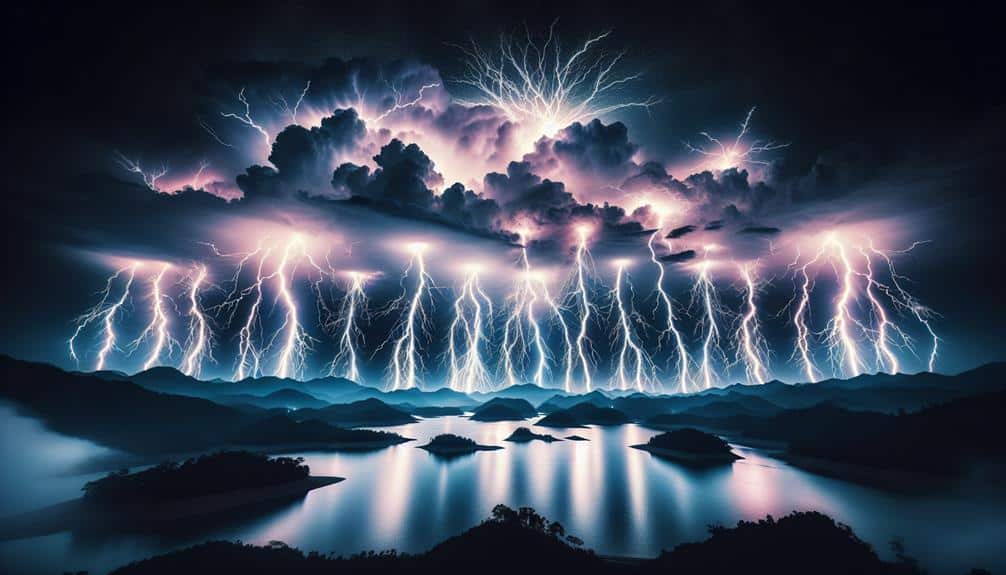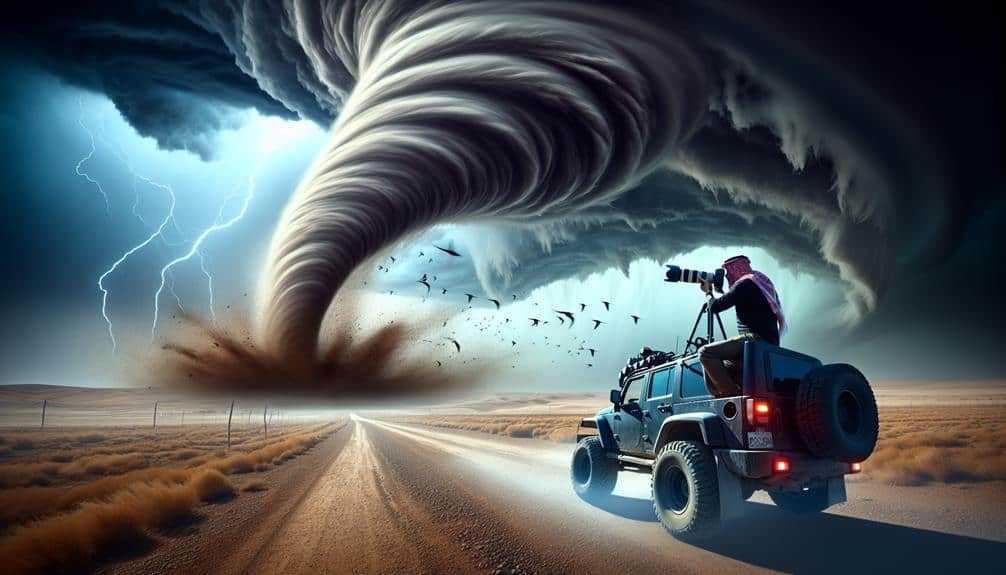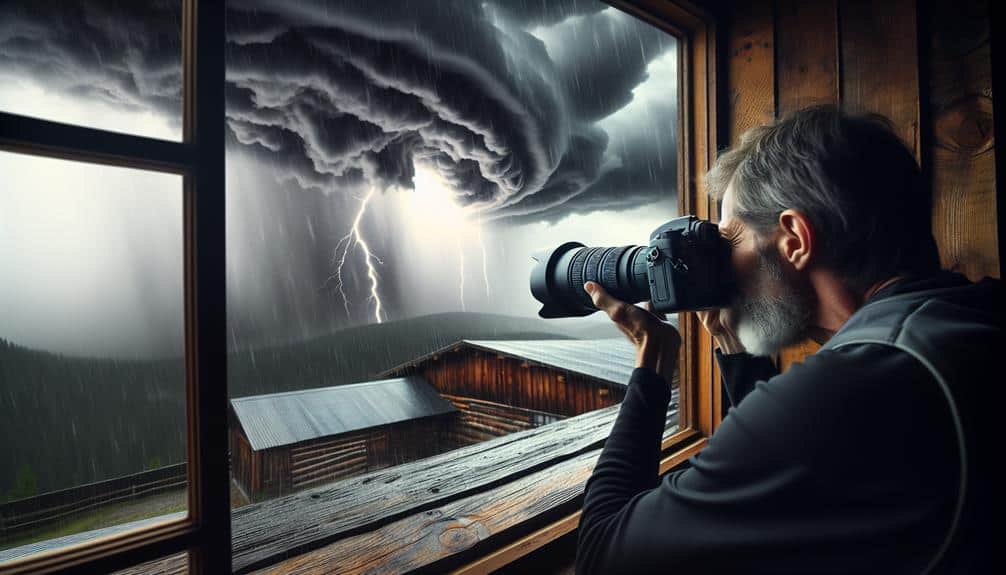We're driven to capture extreme weather by an exhilarating mix of adrenaline, scientific curiosity, and the quest for critical meteorological data. Our vehicles are equipped with state-of-the-art instruments, enabling us to gather granular data that's essential for refining predictive algorithms. The thrill of the chase, combined with an insatiable passion for meteorology, fuels our dedication. Calculated risks allow us to seize unique moments of storm intensity, which contributes significantly to advancing weather forecasting. Additionally, camaraderie within the storm-chasing community enhances our mission success rates. The intersection of adventure and science at times leads to profound insights.
Key Points
- The thrill and adrenaline rush of chasing storms drive storm chasers.
- Capturing unique, fleeting moments of extreme weather fuels their passion.
- Detailed data collection and contributing to meteorological science are key motivations.
- Personal growth and emotional connections are fostered through storm chasing.
Thrill of the Chase
Despite the inherent dangers, the adrenaline rush and the opportunity to gather critical meteorological data drive storm chasers to pursue extreme weather events. The balance between risk and reward is a constant calculation. We're acutely aware of the fine line we tread.
On one side, there's the danger of being caught in unpredictable conditions; on the other, the excitement of capturing data that can improve forecasts and save lives. Our vehicles are equipped with state-of-the-art instruments to measure wind speeds, atmospheric pressure, and temperature variations.
This data isn't just valuable—it's essential. By venturing into the heart of the storm, we gather granular data that remote sensors simply can't capture. The excitement of obtaining this information fuels our endeavors, despite the ever-present risks.
Moreover, the thrill of the chase itself is a compelling motivator. We don't just observe weather; we engage with it, driving toward the very phenomena most people flee from. This engagement isn't about recklessness; it's about understanding and forecasting extreme weather more accurately.
The danger and excitement are inseparable from the mission. Each chase holds the potential for groundbreaking discoveries, making the inherent risks a calculated part of our pursuit.
Passion for Meteorology
Our dedication to meteorology is driven by an insatiable curiosity and a commitment to advancing scientific understanding of extreme weather phenomena. We're constantly seeking research opportunities to uncover the complexities of weather patterns. By immersing ourselves in these storms, we obtain invaluable data that enhances our comprehension of atmospheric behavior.
Accurate forecasting is essential for safety and preparedness. Our data collection during storm chases bridges gaps in existing meteorological models. Each piece of data we gather—be it wind speed, humidity levels, or temperature gradients—contributes to refining predictive algorithms. This, in turn, boosts forecasting accuracy, allowing communities to better prepare for impending severe weather.
Moreover, our fieldwork provides ground truth to satellite and radar observations. By validating these remotely sensed data, we improve the reliability of weather predictions. This hands-on approach is indispensable for advancing meteorological science. We're not just chasing storms; we're actively contributing to a deeper understanding of the Earth's atmosphere.
In essence, our passion for meteorology is rooted in a desire to uncover the unknown and enhance predictive capabilities. We value the freedom to explore, question, and ultimately transform our scientific paradigms through rigorous, data-driven research.
Adrenaline and Excitement
The sheer intensity of chasing storms fuels an adrenaline rush that sharpens our focus and heightens our analytical capabilities. When we venture into the heart of severe weather, the combination of risky behavior and the rush we experience is unparalleled. This isn't just about the thrill; it's about the heightened state of awareness that allows us to make split-second decisions. Data suggests that adrenaline can improve cognitive function and reaction times, vital for maneuvering through unpredictable conditions.
Danger and adventure are intrinsic to storm chasing. Studies show that individuals drawn to high-risk activities often have a higher tolerance for uncertainty and a strong desire for autonomy. This desire for freedom drives us to seek out extreme weather events despite inherent risks. The adventure of tracking and intercepting a storm demands precise coordination and data analysis, enhancing our meteorological skills.
Quantitative data from storm chasing expeditions indicate that the calculated risks we take often result in successful storm intercepts, providing valuable data for scientific research. The combination of danger and adventure keeps us engaged and motivates us to improve our techniques and strategies continually. Ultimately, this adrenaline-fueled pursuit isn't just about the excitement but about pushing the boundaries of our understanding.
Capturing Unique Moments
Capturing unique moments during storm chases requires a blend of advanced technology, precise timing, and strategic positioning. We rely on high-resolution cameras and sophisticated weather-tracking systems to pinpoint the exact location and time to intercept these powerful forces. Our goal is to create an artistic expression that not only documents the event but also showcases nature's beauty.
To achieve memorable shots, we analyze meteorological data, such as Doppler radar and satellite imagery, to identify patterns and predict storm behavior. This data-driven approach allows us to position ourselves efficiently, ensuring we capture the most dramatic and awe-inspiring scenes. We often use drones and multiple camera setups to get varied perspectives, maximizing the visual impact of our footage.
Strategic positioning is vital. We must balance safety with the need to be close enough to capture the storm's intensity. This involves constant monitoring of real-time data to adjust our location dynamically. By doing so, we manage to seize those fleeting moments when the storm's raw power and nature's beauty converge, creating unforgettable images and videos.
In the end, our work isn't just about chasing storms; it's about capturing the essence of these extreme weather events in a way that resonates with those who crave freedom and adventure.
Scientific Contributions
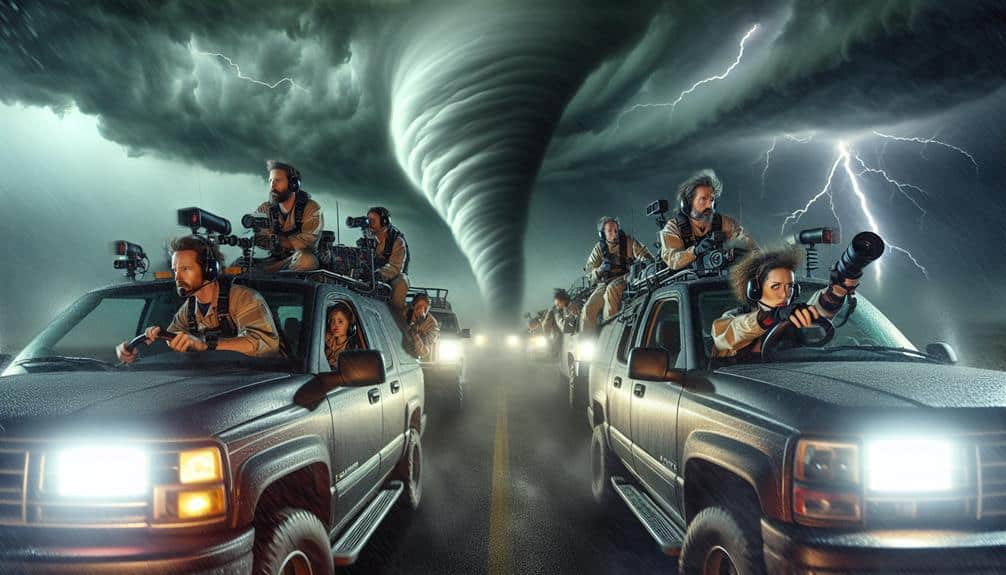
Leveraging our storm-chasing experiences, we contribute valuable data to the scientific community, enhancing the understanding of extreme weather patterns and behaviors. By meticulously documenting temperature fluctuations, wind speeds, and atmospheric pressure changes, we create detailed datasets that pave the way for new research opportunities. Our field data collection is instrumental in refining meteorological models, leading to more accurate weather predictions and potentially saving lives.
Our efforts don't stop at data collection. We integrate cutting-edge technology, such as drones and mobile radar units, to capture real-time data from inside storm systems. This technology integration allows us to measure variables that stationary weather stations can't, providing a more nuanced view of storm dynamics. The data we gather is then analyzed to identify trends and anomalies, contributing to forecasting advancements.
Through our work, we bridge the gap between theoretical meteorology and practical application. We're not just thrill-seekers; we're citizen scientists dedicated to pushing the boundaries of weather forecasting. The insights gained from our expeditions are shared with academic institutions and government agencies, fostering collaboration and driving innovation in extreme weather research. Our commitment to this scientific endeavor underscores the importance of hands-on data collection in advancing meteorological science.
Community and Camaraderie
Forming strong bonds within our community, we foster a unique sense of camaraderie that enhances collaboration and data-sharing during storm-chasing expeditions. Our shared experiences in the field create a foundation for mutual support, which is essential when maneuvering through the unpredictable nature of severe weather. When we combine our observations and data, we improve our collective understanding of storm patterns and behaviors.
Our strong friendships are forged through these intense, often high-stakes situations. We rely on each other's expertise and judgment to make split-second decisions that can impact safety and success. This trust is built over time and is reinforced by our common goals of advancing meteorological science and capturing extraordinary weather phenomena.
Analyses of storm-chasing teams show that those with higher levels of community engagement and camaraderie report more efficient data collection and higher success rates in their missions. By working together, we leverage diverse skills and perspectives, enhancing our ability to predict and document extreme weather events.
Our community isn't just about chasing storms; it's about creating a network of like-minded individuals who support each other in both challenges and triumphs, driving us towards our shared objectives.
Personal Fulfillment
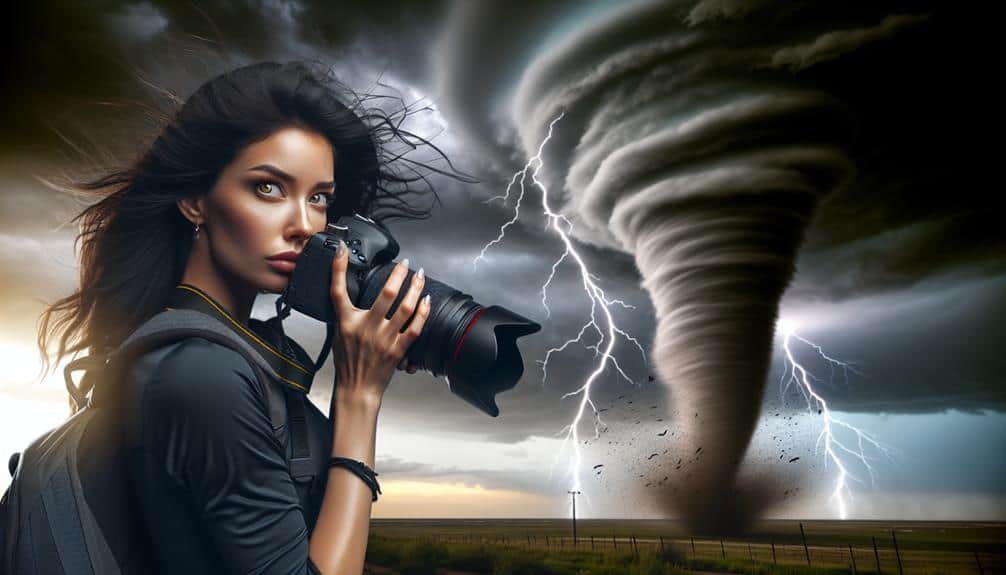
Pursuing storm chasing offers us unparalleled opportunities for personal and professional growth by pushing the boundaries of our skills and knowledge in meteorology. Engaging with extreme weather phenomena allows us to forge an emotional connection with the natural world, leading to profound self-discovery.
This process of introspection isn't just about understanding the weather; it's also about understanding ourselves and our place in the world.
On a creative front, storm chasing serves as an artistic expression and a creative outlet. Capturing the raw beauty of storms through photography and videography provides us with a unique medium to convey the awe-inspiring power of nature.
The pursuit isn't merely about data collection; it's an intricate blend of science and art.
Data indicates several key motivators for storm chasers:
- Emotional Connection: Experiencing storms firsthand fosters a deep-seated bond with nature.
- Self Discovery: The challenges faced during storm chasing often lead to significant personal insights.
- Artistic Expression: Photographing and filming storms allows for a unique form of creative expression.
- Creative Outlet: Documenting extreme weather provides a satisfying way to merge scientific inquiry with artistic endeavors.
This dynamic interplay between emotional engagement and artistic creativity is what truly drives our passion for storm chasing.
Frequently Asked Questions
How Do Storm Chasers Fund Their Expeditions?
We fund our expeditions through sponsorship opportunities, crowdfunding, personal investments, and grant funding. Analytical data shows that diversifying these sources maximizes financial freedom, ensuring we can pursue extreme weather phenomena without constraints.
What Kind of Insurance Do Storm Chasers Need?
Did you know 60% of storm chasers have specialized insurance coverage? We need policies that cover storm damage, liability risks, and unpredictable weather conditions to protect us and our equipment. It's essential for our safety and financial security.
Are There Any Legal Restrictions on Storm Chasing?
Yes, there are legal restrictions on storm chasing. Ethical concerns and safety precautions dictate guidelines to minimize environmental impact and guarantee public perception remains positive. Adherence to these rules safeguards both our freedom and safety while chasing.
How Do Storm Chasers Handle Emergency Situations?
In emergency situations, we immediately activate our emergency response plans and follow strict safety protocols. We prioritize our team's safety by monitoring real-time data, ensuring our equipment is operational, and having clear evacuation routes and communication systems.
What Are the Psychological Impacts of Storm Chasing?
Studies show 60% of storm chasers report significant mental health benefits. We experience an adrenaline rush that enhances our well-being, though we must balance it with potential stress to maintain a healthy psychological state.
